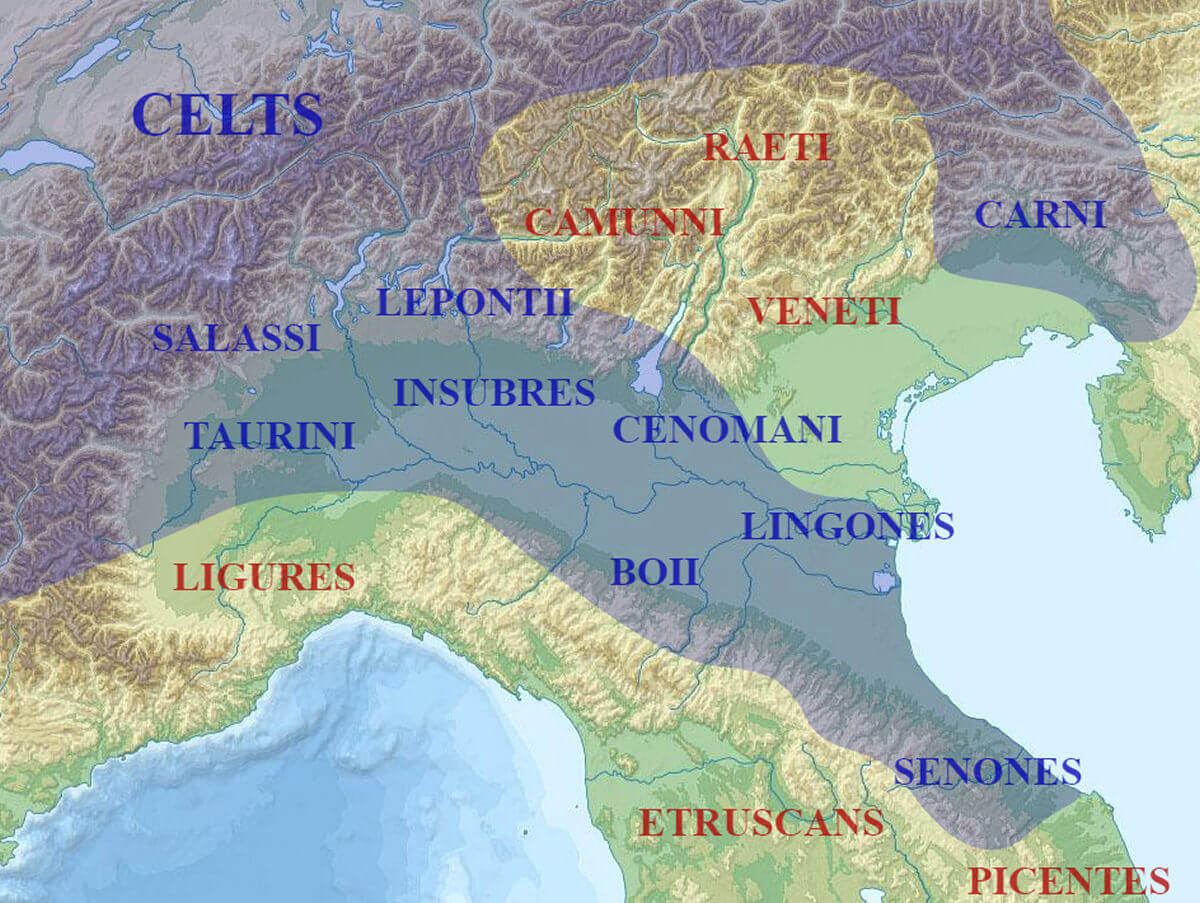As Rome expanded and became master of the Italian peninsula, which meant that foreign wars began to become prevalent in Roman expansion strategy, the Senate became aware that these positions abroad could not remain tenable with northern Italy left unsecured. Pushing Rome's northernmost border to the natural boundary formed by the Alps was a practical (and largely supported) measure.

Nancy Todd - Derived work from Gallia_Cisalpina-fr.svg by Sémhur, CC BY-SA 4.0, via Wikimedia Commons
A map of Cisalpine Gaul showing the approximate distributions of Celtic populations in the area during the 4th and 3rd centuries BC
In 232 BC, the Tribune Gaius Flaminius proposed and passed an agrarian law, ceding land to legionary veterans and poorer classes of citizens. This land, won from the Gauls at the battle of Lake Vadimanus in 283 BC, represented the territory known as Gallia Cisalpina, or Gaul this side (Roman) of the Alps.
Over the next half century, Roman colonists poured into previously occupied Celtic territory, establishing new colonies throughout. The extension of the Via Flaminia (Flaminian Way) angered the resident Gauls, as this new northern road opened up all of northern Italy to Rome, resulting in an even heavier increase in Roman colonization.
A majority of local tribes - mainly the Insubres as well as the Gaesatae from Gallia Transalpina (Gaul across the Alps) - were eventually pushed to the point of open military resistance.
In Rome itself and throughout the Italian mainland, the people remembered the sacking of Rome in the last major Gallic invasion around 390 BC, and were understandably frightened. Fortunately for them, some local tribes who had maintained better relations with Rome since that event, played an intelligence role and kept the Senate informed of Celtic activity.
For nearly 10 years, military action was reserved in the Alps region, and on a mostly minor scale. By 225 BC, however, the Gauls had sufficiently mustered enough forces to invade Roman territory and threaten the city of Rome once more. As many as 70,000 tribal warriors pushed through Etruria, ravaging the country as it had done a century and a half before. The Romans, though, having become hardened from their recent large-scale wars with Carthage and Illyria, were ready.
Using superior legionary and tactical strategies, the Romans surrounded the Gallic invaders near Telamon in 222 BC. Under the command of Consul Marcus Claudius Marcellus, two Roman armies crushed the invasion and put an end to the threat, for the time being.
Plutarch, in his "The Parallel Lives", tells us that Marcellus himself won the day by becoming the third and final commander in Roman history to slay a foreign king in single combat, Britomartus of the Gaesatae:
"The first was Romulus, after having slain Acron, king of the Caeninenses: the second, Cornelius Cossus, who slew Tolumnius the Etruscan: after them Marcellus, having killed Britomartus king of the Gauls; after Marcellus, no man."
After the defeat at Telamon, the Gauls were driven back to the Valley of the Po River and to the Alps. Within a short time, the war ended with Rome victorious and having new lands secured and ready for occupation. Three military colonies were established to hold the Gauls at bay; Placentia and Cremona in Insubrian territory, and Mutina in that of the Boii.
The Via Flaminia was extended from Spoletium to Ariminum; a vital part of Roman expansion. As an added benefit to Roman expansion, the loyalty of Italian farmers who settled on these new lands increased immeasurably, and Roman authority in Italy was further secured.
Hannibal and the Second Punic War would again place this authority in jeopardy, however. As Hannibal crossed the Alps on his way to Italy, his success stirred the Gauls once more, and many joined him against Rome. Cisalpine Gaul wouldn't be fully pacified until Hannibal's defeat; and the rest of Gallia Transalpina until the arrival of Julius Caesar in the mid 1st century BC.
Punic Wars and Expansion - Table of Contents
- First Punic War
- Illyrian Wars
- Conquest of Cisalpine Gaul
- Second Punic War
- First Macedonian War
- Second Macedonian War
- Syrian War
- Third Macedonian War
- Fourth Macedonian War and the Achaean War
- Third Punic War
Did you know...
The Flaminian Way was built by Gaius Flaminius in about 220 BC. It followed the Tiber River valley up to the Apennines and crossed over the mountains at the convenient Scheggia Pass. It then descended on the Adriatic side, along the Metauro valley up to Fanum Fortunae, continued on to Pisaurum (Pesaro), and finally ran on along the coast to Ariminum (Rimini).



